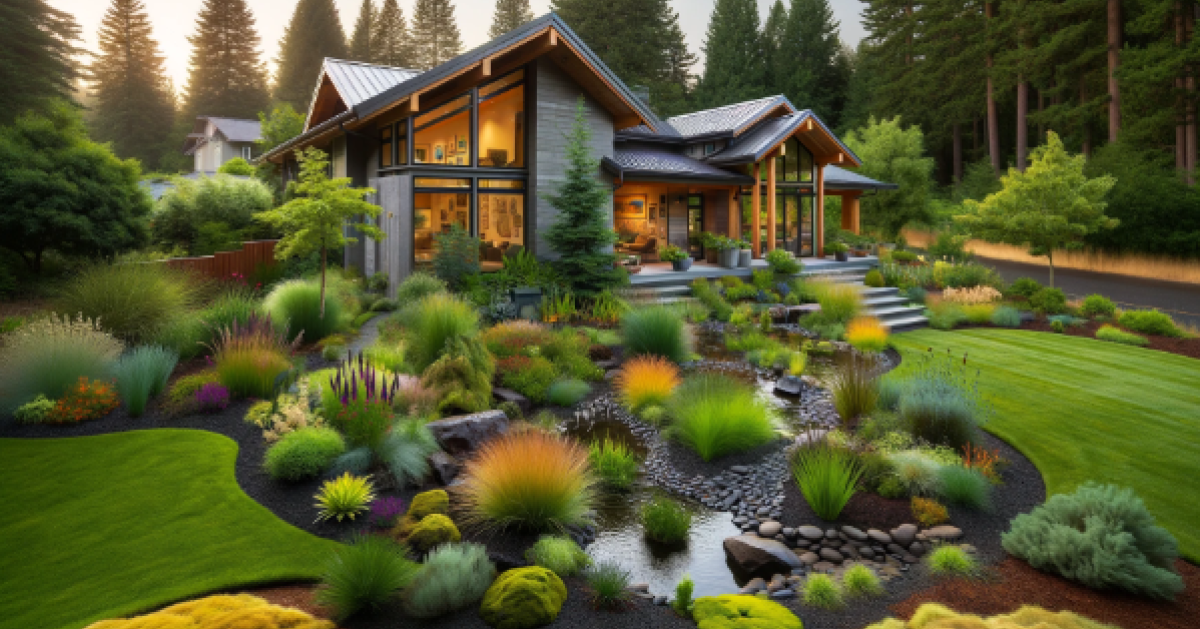Oregon’s frequent rainfall makes effective drainage solutions crucial for homeowners. Without proper management, excess water can lead to soil erosion, foundation damage, and landscape issues. By integrating rain gardens, you can manage stormwater runoff effectively while enhancing your property’s beauty. This article provides practical tips on designing and implementing rain gardens and other drainage solutions tailored to Oregon homes. Rain gardens and drainage solutions for Oregon homes by experts. For more help, work with construction consultants.
The Importance of Effective Drainage in Oregon
Oregon’s abundant rainfall creates significant challenges for homeowners, especially in the wetter western regions. To prevent water-related damage to your home and landscape, effective drainage is essential. Proper management of water flow helps avoid costly repairs and maintains the health of your property.
Prevent Water Damage
First and foremost, preventing water damage to your home is a primary reason to focus on drainage solutions. Water pooling near your foundation can seep into basements or crawl spaces, causing structural damage and mold growth. By managing water effectively, you protect your home’s integrity and avoid expensive repairs.
Maintain Landscape Health
Effective drainage also plays a vital role in keeping your landscape healthy. Excess water can lead to soil erosion, nutrient loss, and plant drowning. Managing water runoff ensures that your garden and lawn remain vibrant, even during Oregon’s rainy season.
Designing a Rain Garden
A rain garden offers a simple yet effective way to manage stormwater runoff while adding beauty to your landscape. These gardens capture and absorb rainwater, reducing runoff and allowing it to filter naturally through the soil.
Select the Right Site
Choosing the right location for your rain garden is crucial. Ideally, place the garden in a low-lying area where water naturally flows or accumulates. However, ensure the garden sits at least 10 feet away from your home’s foundation to prevent water from seeping into the structure. Additionally, avoid placing the garden over septic systems or near underground utilities.
Prepare the Soil
Soil composition is key to a successful rain garden. Oregon’s soil varies, so testing your soil’s drainage capacity is important. If the soil is heavy clay, which drains poorly, amend it with sand and compost to improve permeability. Your goal is to create a soil mixture that allows water to infiltrate quickly, typically within 24 to 48 hours after rainfall.
Choose the Right Plants
Selecting the right plants is essential for an effective rain garden. Native plants are particularly well-suited to Oregon’s climate and require less maintenance. Consider using a mix of grasses, flowering perennials, and shrubs that tolerate both wet and dry conditions. For example, Oregon iris, sedges, and red-twig dogwood thrive in varying moisture levels and attract local wildlife.
Design for Function and Beauty
When designing your rain garden, balance function and aesthetics. Typically, rain gardens are shallow, around 6 to 12 inches deep, with a flat bottom to maximize water absorption. Create berms or use rocks to direct water flow into the garden. Additionally, enhance visual appeal by arranging plants in layers or clusters, mixing different textures and colors.
Implementing Drainage Solutions
Beyond rain gardens, other drainage solutions can help manage water on your property. These options can work alone or complement a rain garden to improve your landscape’s water management.
Permeable Paving
Permeable paving materials, like permeable concrete, pavers, or gravel, allow water to pass through, reducing runoff and recharging groundwater. Use these materials for driveways, walkways, and patios to prevent erosion and lessen the strain on stormwater systems.
French Drains
A French drain effectively diverts water away from your home’s foundation. This system involves a trench filled with gravel or rock and a perforated pipe that directs water away from problem areas. French drains are especially useful in areas with poor drainage or where water tends to pool.
Dry Wells
Dry wells are underground structures designed to collect and disperse stormwater. They are particularly effective in managing runoff from roofs or paved surfaces, preventing water from pooling around your home. By channeling water into a dry well, you allow it to slowly infiltrate the surrounding soil, reducing the risk of water damage.
Swales
Swales are shallow, vegetated channels that manage water runoff by slowing its flow and directing it to designated areas, like a rain garden or dry well. Design swales to follow the natural contours of your land, making them a subtle and effective drainage solution. Plant swales with native vegetation to enhance their water absorption capacity and reduce erosion.
Long-Term Maintenance and Considerations
For optimal performance, rain gardens and other drainage solutions require ongoing maintenance. Regular inspections and care will ensure these systems continue to function effectively and keep your landscape healthy.
Inspect Regularly
Regularly inspect your drainage systems, especially after heavy rain. Look for signs of erosion, pooling water, or blocked drains. Address issues promptly to prevent them from worsening over time.
Maintain Plant Health
In a rain garden, maintaining plant health is crucial. Remove weeds regularly, prune plants as needed, and replace any dead or struggling plants with more suitable species. Healthy plants are essential for absorbing water and preventing soil erosion.
Clear Debris
Keep drainage systems, including gutters, downspouts, and French drains, clear of debris. Leaves, dirt, and other materials can clog these systems, reducing their effectiveness and leading to water buildup.
Conclusion
Rain gardens and other drainage solutions are essential for managing stormwater in Oregon’s rainy climate. By integrating these features into your landscape, you protect your home, enhance your property’s aesthetics, and contribute to environmental sustainability.
Whether you choose to implement a rain garden, install permeable paving, or utilize French drains, effective water management is key to maintaining a healthy, beautiful, and functional landscape. With proper planning and maintenance, these solutions will help you make the most of Oregon’s abundant rainfall, turning potential water problems into opportunities for enhancing your home and garden. Rain gardens and drainage solutions for Oregon homes by experts. For more help, work with construction consultants.


